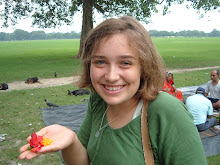As I have been in Kolkata for over three weeks now I feel it is high time that I share some sort of description of the city in which I am living. I've wanted to do so for a while but two factors have held me back. One, I wanted to really "compose" this post. All of my previous ones have been spur-of-the-moment and I'm sure they reflect that in their rambling style. This one I wanted to be different: deliberate. (Honestly, I'm not sure I've succeeded.) Two, I felt it was my responsibility to wait. It being so drastically different here I knew that my early impressions could hardly be fair and certainly not comprehensive.
I take both of these considerations very seriously. For many of you I am commenting on a place that you may never visit, which makes what I say significant in your general understanding of this place and this culture and these people. Knowing this, I wished to pause before I described my reflections on this place. I hope that the added time has given me a slightly wider view of Kolkata, I know it has given me a clearer head.
And thus we have.... Kolkata through the eyes of Hannah Hostetter:
I really didn't know that much about the history of Kolkata before arriving here. In retrospect it is something that I wish I had looked into, just as a reference point, but with all the chaos of finals and preparations I must admit that researching this aspect was far from my mind. However, since coming here I have begun to scratch the surface of Kolkata's history, because I firmly believe that to understand the present one must understand the past. Through some sporatic reading and visiting various historical sites I have learned that Kolkata, or perhaps I should say "Calcutta" for that is it's historical name, began as three small villages. Tension between powers further down the Hoogly River led the East India Company to establish a trading center upstream at the present location of Kolkata's BBD Bag Sqaure in the 1700s. From that point Kolkata continually expanded in size, wealth, and importance as a major trading center for around two hundred years. People were literally attracted from all over the globe to participate in the city's prosperity which has given Kolkata a markedly diverse feeling even to this day. For example, Chinese food is a major cuisine, courtesy of the many early Chinese immigrants. When Britian established imperial rule in India, Calcutta was the capital until 1911 (if I recall correctly) when the capital was changed to Dehli in response to rising political tension in Calcutta. During the period before the change Calcutta was apparently a place of true grandeur- amazing buildings and wealth and education and commerce and arts. After this point I do not know as much--- in general I've found that most books, museums, etc. cut off their discussion after the loss of the capital status. What I have gleaned is basically that after the capital shifted Kolkata saw rough times. It was hit hard in both world wars (I think actually bombed in the second), was very violent during the period surrounding Independence (a Sister who was there said she remembers a time when anyone wearing western clothing on the street was killed), and has been the depository for thousands of poor peasant farmers looking for work when their crops go back. This shift from prosperity to hard times can be seen particularly in the city's architecture. There are absolutely amazing buildings here, even the normal, non-descript buildings have trim reminiscent of Paris, but almost all of them have fallen into disrepair- no paint, broken windows, loss of structual integrity, etc. Whether this is the result of a blatant political statement (not keeping the symbols of past imperialism) or just the result of it being extremely expensive in this tropical climate I can't say-- but what is clear is that Kolkata is both grand and squalid, simultaneously.
Directly connected to this thought, I have found that over the years Kolkata has been called many things: the City of Palaces, the City of the Dead, the cultural center of India, the City of Joy, the city of the dreadful night, and the Second City of the British Empire. After pondering these labels (ironic in their co-existence), I have come up with my own title for Kolkata: the City of Contradictions.
The contradictions I see in it's character range from simple ironic facts of life to the most essential factors of human interactions. As there are quite a few I would like to discuss in detail to give a more complete picture of my life here I will spend the next few blog posts discussing one or two of them at a time so as to make them more managable for both myself and you.
So, I suppose... stay tuned.
<3
Subscribe to:
Post Comments (Atom)

No comments:
Post a Comment